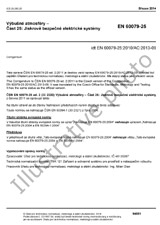We need your consent to use the individual data so that you can see information about your interests, among other things. Click "OK" to give your consent.

IEEE P400.2
IEEE Approved Draft Guide for Field Testing of Shielded Power Cable Systems Using Very Low Frequency (VLF) (less than 1 Hz)
Translate name
STANDARD published on 18.8.2024
| Availability | Sold out |
| Price | ONREQUEST excl. VAT |
| ON REQUEST |
The information about the standard:
Designation standards: IEEE P400.2
Publication date standards: 18.8.2024
SKU: NS-1186507
Approximate weight : 300 g (0.66 lbs)
Country: International technical standard
Annotation of standard text IEEE P400.2 :
Revision Standard - Active - Draft.
Very low frequency (VLF) withstand and other diagnostic tests and measurements that are performed using VLF energization in the field on shielded power cable systems are described in this guide. Whenever possible, cable systems are treated in a similar manner to individual cables. Tables are included as an aid to identifying the effectiveness of the VLF ac voltage test for various cable system insulation problems.
ISBN: 979-8-8557-0584-3, 979-8-8557-0584-3
Number of Pages: 55
Product Code: STDUD26826, STDAPE26826
Keywords: cable fault locating, cable system testing, cable testing, condition assessment, dielectric spectroscopy, grounding, hipot testing, IEEE 400.2™, partial discharge testing, proof testing, safety, tangent delta testing, very low frequency testing, VLF ac voltage testing
Category: Insulated Conductors
Draft Number: P400.2/D11, Feb 2024 - UNAPPROVED DRAFT, P400.2/D11, Feb 2024 - APPROVED DRAFT
We recommend:
Technical standards updating
Do you want to make sure you use only the valid technical standards?
We can offer you a solution which will provide you a monthly overview concerning the updating of standards which you use.
Would you like to know more? Look at this page.



 Cookies
Cookies
